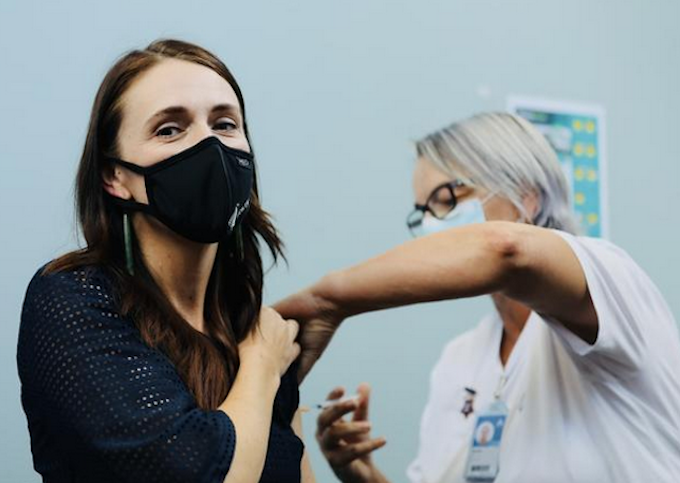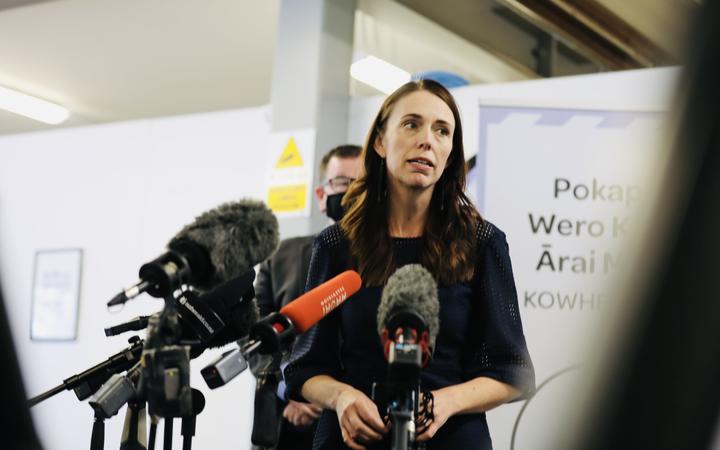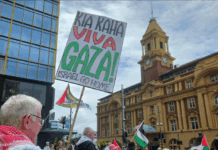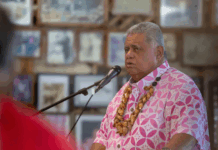
Prime Minister Jacinda Ardern says New Zealand will move to the red traffic light setting if omicron is spreading in the community following reports that a border worker who was yesterday reported as covid-19 positive has been confirmed to have the omicron variant.
On Tonga, Defence Minister Peeni Henare says he understands power has been restored in large parts of Nuku’alofa following Saturday’s eruption of Hunga Tonga-Hunga Haʻapai volcano.
The government leaders were speaking at today’s media briefing.
- READ MORE: NZ border worker confirmed as omicron case
- Covid-19 update: 16 new community cases
- Tongan volcano eruption reports
- RNZ live updates on Tonga
More than 120,000 doses of the children’s Pfizer vaccine for covid-19 are ready to go at clinics around the country.
Tamariki aged five to 11 are eligible for the first of two recommended doses, eight weeks apart.
Ardern said it was pleasing to see people had been lining up today to be the first through the door at vaccination centres, and lines have been clearing quickly.
Henare, who is also Whānau Ora and Associate Health Minister, said the government had been working closely with iwi leaders to ensure tamariki could receive the vaccine, and was looking towards the schools for when they reopened.
Another milestone day
Today was another milestone day in the vaccination campaign in New Zealand, Ardern said.
New Zealanders have been able to get boosters since early January and online bookings open from today.
“For children of course they are able to be booked in now via Book My Vaccine … we’ve heard that whānau are coming in to get both their booster and to bring their children in to be vaccinated as well.”

Today Ardern received her booster dose of the covid-19 vaccination.
She says it was possible 80 percent of the country’s population could be boosted by the end of February.
She thanked all those putting in mahi so far, to get the booster roll-out well underway.
Over half of eligible New Zealanders have had their booster, she says.
66,000 make bookings
“The traffic on the website today has been good, she says, with over 66,000 people having made a booking by midday compared to about 12,000 on other recent days.
Aotearoa’s first community case of the omicron variant of covid-19 was announced yesterday. The person is a border worker in Auckland and has 50 close contacts.
The worker, who was infectious from January 10, took two bus services in Auckland and visited a supermarket and four other stores in the city.
Ardern said when it comes to omicron in the community it is a matter of when, not if.
“New Zealanders have had the break that we hoped they would get but we know that with omicron it is a case of when, not if, and that is why the booster campaign is just so critical.”
The government would look to move into the red traffic light setting if Omicron was spreading in the community, Ardern says.
“What I expect is over the coming weeks to be able to share with you some of the additional preparation that has been done over and above the work that we did on delta, for the specific issue of omicron and what it represents.
“We have the ability to learn from other nations and see the impact or the way that omicron is behaving and prepare ourselves.”
Changes in testing, isiolation
“This will mean changes including to the way testing, isolation and contact tracing is done, and the details will be shared in the coming weeks.
“We’ve managed to get delta down to extraordinarily low levels, that means the risk posed by opening that border, now is very low. We are in the right place now to remove those requirements.”
Ardern said the traffic light system was designed to deal with surges, outbreaks and had the possibility of new variants in mind. She said the measures under the red setting were designed to slow the spread of a variant like omicron.
Another update on traffic light settings would be given on Thursday, she said.
Vaccination passes do not currently have the booster set within them. Ardern said the option to include that in future is being retained, but getting a booster remained the best way to protect against omicron.
“We’re doing what we can but I think it would be wrong to assume those border measures will be sufficient. At some point we will see omicron in the community … we should always assume at any time.”
Eruption crisis in Tonga
Defence Minister Peeni Henare said he understood power had been restored in large parts of the Tongan capital Nuku’alofa.
Ardern said the RNZAF Orion had been undertaking an assessment from the air of the outer islands in particular to provide that information to the Tongan authorities.
The C-130 would perform naval drops, with planning being done to enable that regardless of the status of the airport.
“I understand that on the ground of course that Tonga has also now by sea dispatched to the outer islands.”
She says the C-130 was expected to fly today regardless, and would be able to meet immediate supply needs.
Henare said it is being ensured that the C-130 had the necessities on board. He said the aerial assessment being done would help with that.
The response must be directed to where it was needed the most, he said.
Navy able to deploy quickly
Ardern said the navy was able to deploy very quickly.
She said communication had been difficult but the flight today along with communication with officials on the ground would help establish the needs of those in Tonga, but they knew water was needed.
She cautioned that while there had been reports that some islands had seen no casualties, it was still early days.
It is thought the connectivity problems with the underwater cable stemmed from power outages, she said.
This article is republished under a community partnership agreement with RNZ.











































